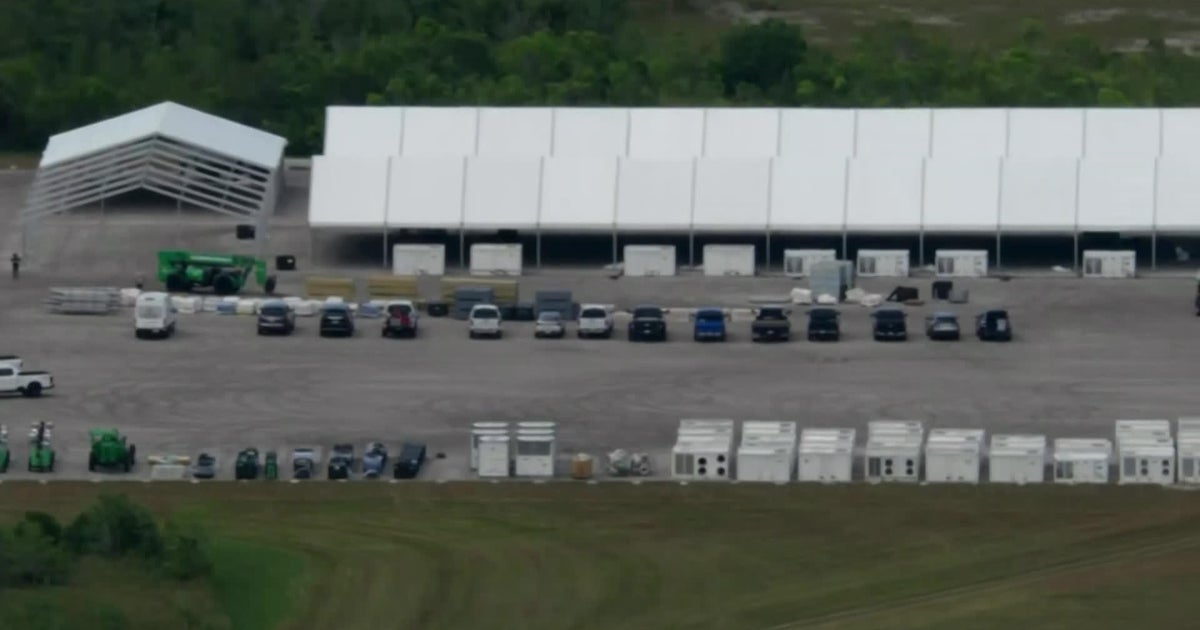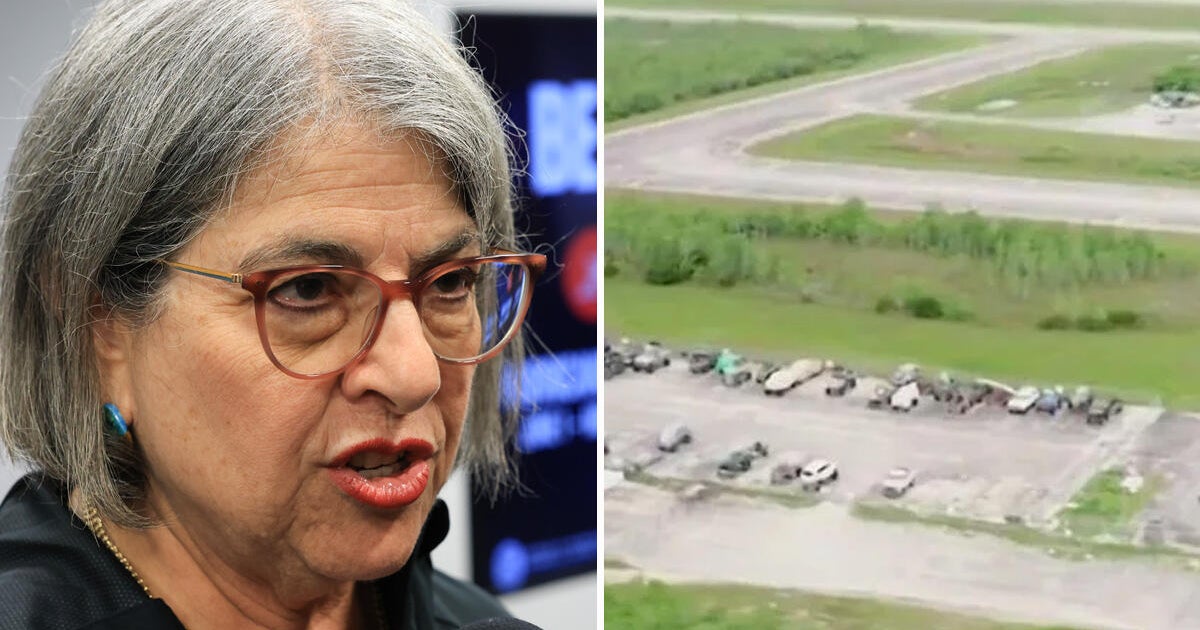Where is "Alligator Alcatraz"? Florida migrant camp rises on land once eyed for supersonic jetport
A temporary migrant detention site located deep in the Florida Everglades is quickly taking shape — and drawing mounting controversy.
Dubbed "Alligator Alcatraz," Florida officials are racing ahead with the construction of the facility to help carry out President Donald Trump's mass deportation agenda. The planned development has the backing of the U.S. Department of Homeland Security, which has called the site "innovative" and "cost-effective."
On the other hand, human rights advocates and environmentalists are concerned about the facility's construction in the remote and ecologically sensitive region, about 45 miles west of Downtown Miami. Native American tribal leaders consider the land sacred.
However, this is not the first time that the swath of land has been an area of interest for further development.
Here is a brief history of the land where Florida officials and the federal government are building "Alligator Alcatraz."
History of the Big Cypress land where "Alligator Alcatraz" is being built
According to the , humans have inhabited the Big Cypress Swamp – the wetlands that encompass the proposed "Alligator Alcatraz" site – for almost 3,000 years. Some researchers believe that the earliest inhabitants came to the area about 4,500 years ago.
Teeming with life, the unique ecosystem provided a bountiful source of sustenance for the first peoples to call it home.
"Evidence of seasonal and even permanent settlement, albeit limited, has been found deep within its large expanse," the association said. "Ongoing research may yet yield even more fascinating clues."
Within Big Cypress, the Calusa and the Tequesta tribes have lived in the area.
From 500 B.C.E to 1513, settlements of the native Glades people in the region were largely transient, with camps being mostly used for hunting, fishing and food-processing, the Florida National Parks Association said.
In the centuries after contact with Europeans in the early 1500s, the Glades people's population declined due to war, slave raids and disease. By 1763, when the Spanish ceded Florida to Great Britain, many of the remaining South Florida tribes had already resettled in Cuba, where many had also died from disease. While some might have remained in South Florida into the 1800s, the association said they were probably absorbed into the incoming migration of Seminole and Miccosukee tribes from the northern part of the state.
The abandoned Everglades Jetport project
According to the , Florida officials in the 1960s proposed building a jetport in the area to support South Florida's booming population and their "futuristic aspirations of aircraft." The bold plan included advanced aircraft capable of carrying up to 1,000 passengers and flying coast-to-coast at supersonic speed.
But, aeronautical engineers understood that any aircraft capable of breaking the sound barrier over populated areas "would not be tolerated," even though supersonic airliners were considered to be "the way of the future," the NPS said.
As a result, the Dade County Port Authority purchased 39 square miles of remote swamp land just north of the Everglades National Park boundary – with plans to build the Everglades Jetport.
As work began in 1968, Everglades Jetport was intended to have six runways and a 1,000-foot-wide corridor that would link the airport to both Florida's east and west coasts with a new interstate highway and even a monorail high-speed mass transit system. Expected to be about five times the size of New York's John F. Kennedy International Airport, the Everglades Jetport would have been the largest airport in the world, according to the NPS.
However, the Everglades Jetport never came into fruition after Russell E. Train, then-undersecretary of the U.S. Department of the Interior, tasked Dr. Luna B. Leopold to research the potential impacts of the jetport on the surrounding area.
Leopold, a senior research hydrologist and son of the renowned conservationist Aldo Leopold, wrote a report expressing "strong opposition" to the Everglades Jetport. According to the NPS, this report was considered to be the first environmental impact study conducted for Florida.
"Development of the proposed jetport and its attendant facilities will lead to land drainage and development for agriculture, transportation, and services in the Big Cypress Swamp, which will inexorably destroy the South Florida ecosystem and thus the Everglades National Park," the 1969 report said.
Alarmed by the research, a coalition of hunters, conservationists and activists, including Marjory Stoneman Douglas, pressured the port authority to find another location for the jetport.
By 1970, all work on the proposed airport was halted, and the port authority began searching for another location.
The Dade-Collier Training and Transition Airport
In the early 1970s, the land was developed into the Dade-Collier Training and Transition Airport (TNT), an aviation training facility with only one runway.
According to , the site was planned as a replacement runway for MIA to serve South Florida, but environmental concerns in the late 1970s through early 1980s stopped further development.
The 24,960-acre property has about 900 acres of developed and operational land, while the remaining area is managed and operated by the Florida Game and Freshwater Fish Commission.
Since its original configuration, TNT's most notable enhancements have been a runway overlay and lighting upgrade in 1992, which cost $3.5 million, and taxiway rejuvenation in 1996, which cost another $100,000, MIA said.
Since then, the Miami-Dade Aviation Department has been exploring ways to generate further revenue at TNT.
The failed Miami Air Show plan
Decades later, the site was once again brought up in discussion.
In 2015, a group of Miami-Dade officials traveled to France with hopes of reviving the idea of bringing a global aviation expo to the Miami area.
"Long a pet project in Miami-Dade's economic-development circles, the idea of a Miami Air Show would be to create the Western Hemisphere's version of the popular Paris Airshow," reported , CBS News Miami's news partners.
Originally, county officials wanted to put the show in Homestead but the Pentagon stopped them in 2011 when it rejected use of the runways at its semi-retired air base there.
Without the Pentagon's cooperation, the county turned to TNT as a possible site.
Unlike other air shows, which are better known for watching aerial aerobatics, the Paris Air Show is more of a showroom for the jetliner-manufacturing industry. So, Miami-Dade County proposed TNT's location and the area's "international cachet" as selling points to develop such a show to target buyers in the Americas, the Herald reported.
However, much like past plans, the facility's site has continuously met resistance from conservation activists and groups, and developments of the Miami Air Show have since been halted as well.
DHS migrant camp construction
On June 19, Florida Attorney General James Uthmeier proposed the idea of building a temporary detention facility in the Everglades that he called "Alligator Alcatraz" to house U.S. Immigration and Customs Enforcement detainees.
Uthmeier said the facility would sit on the already constructed runway at TNT and hold more than 1,000 beds.
At the time, officials hadn't shared the projected cost of the facility, but said it could be operational within 30 to 60 days after construction. Rachel Johnson, deputy chief of staff for Miami-Dade County Mayor Daniella Levine Cava, said the county sent state officials an updated appraisal and deeper financial analysis request "to make sure we maximize the value of this public asset on behalf of Miami-Dade taxpayers."
DHS Secretary Kristi Noem said on June 23 that the federal government will fund Florida's efforts to set up immigration detention centers, including "Alligator Alcatraz."
She said they will be funded "in large part" by the Federal Emergency Management Agency's (FEMA) shelter and services program, a congressional initiative that supported groups and cities receiving migrants and asylum seekers released from federal custody along the U.S.-Mexico border.
That same day, Uthmeier said that the federal government had "approved" the construction plans for "Alligator Alcatraz" and other facilities, which could collectively house as many as 5,000 detainees.
Florida officials recently commandeered the land by using state emergency powers under an executive order issued by Gov. Ron DeSantis during the Biden administration to respond to what the governor deemed "a crisis caused by illegal immigration."
A also on June 23 stated that "Alligator Alcatraz" construction could be ready "in just days."




